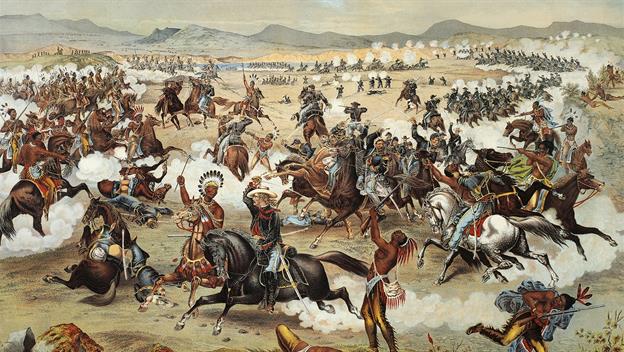History.com has this for 31 August:
On 31 August 1876, Native American forces led by Chief Crazy Horse and Chief Sitting Bull defeated the Army troops of Lieutenant Colonel George Armstrong Custer in a bloody battle near southern Montana’s Little Bighorn River.
Crazy Horse and Sitting Bull, leaders of the Sioux tribe on the Great Plains, strongly resisted the mid-nineteenth-century efforts of the government to confine their people to reservations. In 1875, after gold was discovered in South Dakota’s Black Hills, the Army ignored previous treaty agreements and invaded the region. This betrayal led many Sioux and Cheyenne tribesmen to leave their reservations and join Sitting Bull and Crazy Horse in Montana. By the late spring of 1876, more than ten thousand Native Americans had gathered in a camp along the Little Bighorn River, which they called the Greasy Grass, in defiance of a War Department order to return to their reservations or risk being attacked.
In mid-June, three columns of soldiers lined up against the camp and prepared to march. A force of twelve hundred Native Americans turned back the first column on 17 June. Five days later, General Alfred Terry ordered Custer’s Seventh Cavalry to scout ahead for enemy troops. On the morning of 25 June, Custer drew near the camp and decided to press on, rather than wait for reinforcements.
At mid-day, Custer’s six hundred men entered the Little Bighorn Valley. Among the Native Americans, word quickly spread of the impending attack. The older Sitting Bull rallied the warriors and saw to the safety of the women and children, while Crazy Horse set off with a large force to meet the attackers head on. Despite Custer’s desperate attempts to regroup his men, they were quickly overwhelmed. Custer and some two hundred men in his battalion were attacked by as many as three thousand Native Americans; within an hour, Custer and every one of his soldiers were dead.
The Battle of Little Bighorn, also called Custer’s Last Stand, marked the most decisive Native American victory and the worst Army defeat in the long Plains Indian War. The gruesome fate of Custer and his men outraged many white Americans and confirmed their image of the Indians as wild and bloodthirsty. Meanwhile, the government increased its efforts to subdue the tribes. Within five years, almost all of the Sioux and Cheyenne would be confined to reservations.
Rico says that Custer was an ambitious idiot, and cost a lot of lives, fortunately including his own...








No comments:
Post a Comment